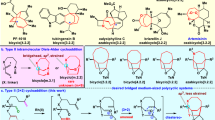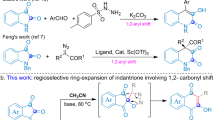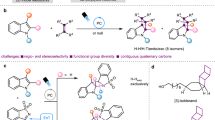Abstract
Aromaticity is a phenomenon that is linked to the improved stability of organic compounds. Its occurrence is predicted by Hückel’s rule, which states that an aromatic compound must be flat, fully conjugated and have (4n + 2) π electrons. The most encountered aromatic structure is the benzenoid ring, which is observed in a wide variety of pharmaceuticals and organic materials. Expanded monocyclic structures are also of substantial interest as they would allow one to experimentally investigate the relationships between aromaticity, stability, reactivity and ring size. However, larger rings such as [10]annulene are often non-planar and non-aromatic due to angle strain present in their planar conformation. Inspired by earlier computational work, we show here that the presence of both a fused cyclopropane and an internal alkyne in a [10]annulene framework provides a planar and highly aromatic structure. The resulting dehydro[10]annulene is bench stable and can be stored for extended periods of time.

This is a preview of subscription content, access via your institution
Access options
Subscribe to this journal
Receive 12 digital issues and online access to articles
$119.00 per year
only $9.92 per issue
Buy this article
- Purchase on Springer Link
- Instant access to full article PDF
Prices may be subject to local taxes which are calculated during checkout






Similar content being viewed by others
Data availability
General information, experimental procedures, compound characterization data, X-ray crystallographic data, 1H NMR/13C NMR spectra, HPLC data, computational details and xyz coordinates of computed structures are all available in the Supplementary Information. Crystallographic data for the structures reported in this article have been deposited at the Cambridge Crystallographic Data Centre, under deposition number CCDC 2092414 (cocrystal of trans-22 and 23). Copies of the crystallographic data can be obtained free of charge via https://www.ccdc.cam.ac.uk/structures/.
References
Schleyer, P. V. R. Introduction: aromaticity. Chem. Rev. 101, 1115–1118 (2001).
Schleyer, P. V. R., Wu, J. I., Cossío, F. P. & Fernández, I. Aromaticity in transition structures. Chem. Soc. Rev. 43, 4909–4921 (2014).
Peart, P. A., Repka, L. M. & Tovar, J. D. Emerging prospects for unusual aromaticity in organic electronic materials: the case for methano[10]annulene. Eur. J. Org. Chem. 2008, 2193–2206 (2008).
Hückel, E. Zur Quantentheorie der Doppelbindung. Z. Phys. 60, 423–456 (1930).
von E. Doering, W. & Detert, F. L. Cycloheptatrienylium oxide. J. Am. Chem. Soc. 73, 876–877 (1951).
Spitler, E. L., Johnson, C. A. & Haley, M. M. Renaissance of annulene chemistry. Chem. Rev. 106, 5344–5386 (2006).
Feixas, F., Matito, E., Poater, J. & Solà, M. Quantifying aromaticity with electron delocalisation measures. Chem. Soc. Rev. 44, 6434–6451 (2015).
Gershoni-Poranne, R. & Stanger, A. Magnetic criteria of aromaticity. Chem. Soc. Rev. 44, 6597–6615 (2015).
Cyrański, M. K. Energetic aspects of cyclic pi-electron delocalization: evaluation of the methods of estimating aromatic stabilization energies. Chem. Rev. 105, 3773–3811 (2005).
Breslow, R., Hover, H. & Chang, H. W. The synthesis and stability of some cyclopropenyl cations with alkyl substituents. J. Am. Chem. Soc. 84, 3168–3174 (1962).
Olah, G. A., Bollinger, J. M. & White, A. M. Stable carbonium ions. LXXXIX. Tetramethylcyclobutenium dication, an aromatic 2.pi.-electron system. J. Am. Chem. Soc. 91, 3667–3669 (1969).
Boche, G., Etzrodt, H., Marsch, M. & Thiel, W. The dianion 1,2,3,4-tetraphenylcyclobutadienediide. Angew. Chem. Int. Ed. Engl. 21, 133–133 (1982).
Peters, D. 349. The cyclopentadienyl anion. Part I. 1,2-dimethoxycarbonylcyclopentadienylsodium, a stabilised cyclopentadienyl anion. J. Chem. Soc. (Resumed) 1757–1760 (1959).
Von E.Doering, W. & Knox, L. H. The cycloheptatrienylium (tropylium) ion. J. Am. Chem. Soc. 76, 3203–3206 (1954).
Olah, G. A., Staral, J. S. & Paquette, L. A. Novel aromatic systems. III. The 1,3,5,7-tetramethylcyclooctatetraene dication, the first 8C-6.pi. Hueckeloid system. J. Am. Chem. Soc. 98, 1267–1269 (1976).
Katz, T. J. The sycloöctatetraenyl dianion. J. Am. Chem. Soc. 82, 3784–3785 (1960).
Sondheimer, F., Wolovsky, R. & Amiel, Y. Unsaturated macrocyclic compounds. XXIII.1 The synthesis of the fully conjugated macrocyclic polyenes cycloöctadecanonaene ([18]annulene),2 cyclotetracosadodecaene ([24]annulene), and cyclotriacontapentadecaene ([30]annulene). J. Am. Chem. Soc. 84, 274–284 (1962).
Ermer, O. Concerning the structure of [18]annulene. Helv. Chim. Acta 88, 2262–2266 (2005).
Lungerich, D. et al. [18]Annulene put into a new perspective. Chem. Commun. 52, 4710–4713 (2016).
Baldridge, K. K. & Siegel, J. S. Correlation of empirical δ(TMS) and absolute NMR chemical shifts predicted by ab initio computations. J. Phys. Chem. A. 103, 4038–4042 (1999).
Kwan, E. E. & Liu, R. Y. Enhancing NMR prediction for organic compounds using molecular dynamics. J. Chem. Theory Comput. 11, 5083–5089 (2015).
Peeks, M. D., Claridge, T. D. W. & Anderson, H. L. Aromatic and antiaromatic ring currents in a molecular nanoring. Nature 541, 200–203 (2017).
Masamune, S. & Seidner, R. T. [10]Annulenes. J. Chem. Soc. D. 542–544 (1969).
Masamune, S. & Darby, N. [10]Annulenes and other (CH)10 hydrocarbons. Acc. Chem. Res. 5, 272–281 (1972).
Castro, C., Karney, W. L., McShane, C. M. & Pemberton, R. P. [10]Annulene: bond shifting and conformational mechanisms for automerization. J. Org. Chem. 71, 3001–3006 (2006).
Farnell, L., Kao, J., Radom, L. & Schaefer, H. F. Structures and stabilities of isomeric [10]annulenes. J. Am. Chem. Soc. 103, 2147–2151 (1981).
Xie, Y., Schaefer, H. F., Liang, G. & Bowen, J. P. [10]Annulene: the wealth of energetically low-lying structural isomers of the same (CH)10 connectivity. J. Am. Chem. Soc. 116, 1442–1449 (1994).
Sulzbach, H. M., Schaefer, H. F., Klopper, W. & Lüthi, H. P. Exploring the boundary between aromatic and olefinic character: bad news for second-order perturbation theory and density functional schemes. J. Am. Chem. Soc. 118, 3519–3520 (1996).
King, R. A., Crawford, T. D., Stanton, J. F. & Schaefer, H. F. Conformations of [10]annulene: more bad news for density functional theory and second-order perturbation theory. J. Am. Chem. Soc. 121, 10788–10793 (1999).
Sulzbach, H. M., Schleyer, P. V. R., Jiao, H., Xie, Y. & Schaefer, H. F. A [10]annulene isomer may be aromatic, after all!. J. Am. Chem. Soc. 117, 1369–1373 (1995).
Myers, A. G. & Finney, N. S. Synthesis of 1,6-didehydro[10]annulene. Observation of its exceptionally facile rearrangement to form the biradical 1,5-dehydronaphthalene. J. Am. Chem. Soc. 114, 10986–10987 (1992).
Vogel, E. & Roth, H. D. The cyclodecapentaene system. Angew. Chem. Int. Ed. Engl. 3, 228–229 (1964).
Dewey, H. J. et al. Excited states of methano-bridged [10]-, [14]-, and [18]annulenes. Evidence for strong transannular interaction, and relation to homoaromaticity. J. Am. Chem. Soc. 102, 6412–6417 (1980).
Caramori, G. F., de Oliveira, K. T., Galembeck, S. E., Bultinck, P. & Constantino, M. G. Aromaticity and homoaromaticity in methano[10]annulenes. J. Org. Chem. 72, 76–85 (2007).
Scott, L. T., Brunsvold, W. R., Kirms, M. A. & Erden, I. Homoazulene. J. Am. Chem. Soc. 103, 5216–5220 (1981).
Schleyer, Pv. R., Jiao, H., Sulzbach, H. M. & Schaefer, H. F. Highly aromatic planar all-cis-[10]annulene derivatives. J. Am. Chem. Soc. 118, 2093–2094 (1996).
Billups, W. E., Blakeney, A. J. & Chow, W. Y. A benzocyclopropene synthesis. J. Chem. Soc. D. 1461–1462 (1971).
Davalian, D., Garratt, P. J., Koller, W. & Mansuri, M. M. Strained aromatic systems. Synthesis of cyclopropabenzocyclobutenes, cyclopropanaphthocylobutenes, and related compounds. J. Org. Chem. 45, 4183–4193 (1980).
Moore, W. R. & Ward, H. R. The formation of allenes from gem-dihalocyclopropanes by reaction with alkyllithium reagents1,2. J. Org. Chem. 27, 4179–4181 (1962).
Castillo, A. M., Patiny, L. & Wist, J. Fast and accurate algorithm for the simulation of NMR spectra of large spin systems. J. Magn. Reson. 209, 123–130 (2011).
Schleyer, P. V. R., Maerker, C., Dransfeld, A., Jiao, H. & van Eikema Hommes, N. J. R. Nucleus-independent chemical shifts: a simple and efficient aromaticity probe. J. Am. Chem. Soc. 118, 6317–6318 (1996).
Báez-Grez, R., Ruiz, L., Pino-Rios, R. & Tiznado, W. Which NICS method is most consistent with ring current analysis? Assessment in simple monocycles. RSC Adv. 8, 13446–13453 (2018).
Geuenich, D., Hess, K., Köhler, F. & Herges, R. Anisotropy of the induced current density (ACID), a general method to quantify and visualize electronic delocalization. Chem. Rev. 105, 3758–3772 (2005).
Glendening, E. D., Landis, C. R. & Weinhold, F. Resonance theory reboot. J. Am. Chem. Soc. 141, 4156–4166 (2019).
Siegel, J. S. Mills—Nixon effect: wherefore art thou? Angew. Chem. Int. Ed. Engl. 33, 1721–1723 (1994).
Acknowledgements
We thank the Natural Sciences and Engineering Research Council of Canada (grant no. RGPIN-2017–06230 to M.G.), the Canada Foundation for Innovation and the Province of Saskatchewan (Saskatchewan Innovation and Opportunity Scholarship to K.P.) for financial support. We thank the Saskatchewan Structural Sciences Centre and J. Zhu. We thank D. Ward and S. Langdon for helpful discussions and suggestions.
Author information
Authors and Affiliations
Contributions
K.P., C.S.B., B.E.L. and S.N.G. performed the experiments. K.P. and C.S.B. performed the computations. The project was conceptualized by K.P. and M.G., who also cowrote the manuscript.
Corresponding author
Ethics declarations
Competing interests
The authors declare no competing interests.
Peer review
Peer review information
Nature Synthesis thanks the anonymous reviewers for their contribution to the peer review of this work. Primary Handling Editor: Thomas West, in collaboration with the Nature Synthesis team.
Additional information
Publisher’s note Springer Nature remains neutral with regard to jurisdictional claims in published maps and institutional affiliations.
Supplementary information
Supplementary Information
General information, experimental procedures, compound characterization data, X-ray crystallographic data, 1H NMR/13C NMR spectra, HPLC data, computational details and xyz coordinates of computed structures.
Supplementary Data 1
X-ray data for trans-22/23 cocrystal, CCDC 2092414.
Rights and permissions
Springer Nature or its licensor holds exclusive rights to this article under a publishing agreement with the author(s) or other rightsholder(s); author self-archiving of the accepted manuscript version of this article is solely governed by the terms of such publishing agreement and applicable law.
About this article
Cite this article
Parmar, K., Blaquiere, C.S., Lukan, B.E. et al. Synthesis of a highly aromatic and planar dehydro [10]annulene derivative. Nat. Synth 1, 696–700 (2022). https://doi.org/10.1038/s44160-022-00135-z
Received:
Accepted:
Published:
Issue Date:
DOI: https://doi.org/10.1038/s44160-022-00135-z



